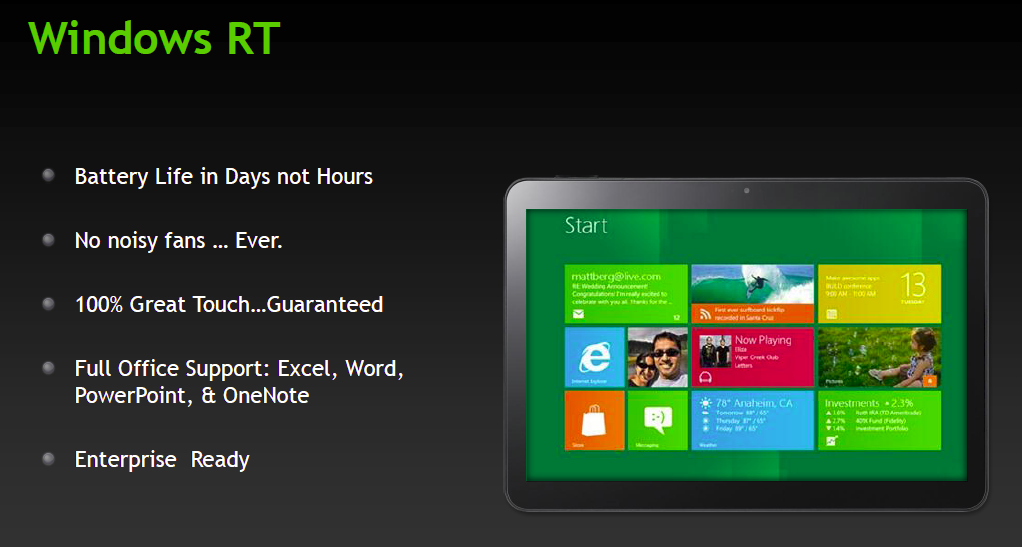Which Windows will make for a better tablet?

With the Release Preview due in just a few weeks, there are still many questions about Windows 8. Some of the biggest mysteries surround Windows RT.
Microsoft has made no secret of its plans to target tablets with the next release of Windows. But there will actually be two different types of Windows tablets. The first will look a lot like current Windows PCs complete with processors from Intel and AMD, based on the x86 architecture, and either Windows 8 or Windows 8 Pro. The second type will use processors based on the ARM architecture--like nearly all smartphones and tablets--and Windows RT. (Until recently, Microsoft referred to this as Windows on ARM, or WOA.) Nvidia, Qualcomm and Texas Instruments will provide chips for these tablets.
Like Windows 8, Windows RT will eventually be available on devices of all shapes and sizes including tablets, laptops and hybrids. But it is really meant for tablets. The question is which will make for a better tablet, Windows 8 on x86 or Windows RT on ARM?
Both types of tablets will look similar. Microsoft has already stated that Windows 8 and Windows RT have "a high degree of commonality and very significant shared code." But there are major differences. Windows RT won't be sold separately; it will be available only on devices with integrated hardware, firmware and software just like current tablets. Windows RT will have Metro apps such as Mail, Calendar and People, but its version of desktop Windows will be limited. It will include File Explorer and desktop Internet Explorer, but you can't add your own desktop apps. Windows RT devices will come with touch-optimized versions of Microsoft Word, Excel, PowerPoint and OneNote. Finally, like Windows 8 for consumers, Windows RT is missing several enterprise features in Windows 8 Pro designed to make devices easier to manage and secure.
For companies, the appeal of Windows 8 Pro on x86 is obvious. Both laptops and tablets will have the same operating system and run the same Metro and desktop apps. And they can be managed using existing Windows tools and policies. Then again, the same can be said of Windows 7 tablets and, aside from certain niches, they've failed to make a dent. Instead employees have been choosing their own devices--a phenomenon known as BYOD-- forcing companies to find new tools such as Good for Enterprise to support and manage tablets and smartphones.
Manageability won't be enough. The x86 ecosystems still has to demonstrate that it can deliver a tablet that is thin and lightweight, has long battery life and is priced competitively. Intel also needs to deliver on features such as rapid start-up and connected standby that it has been talking about for some time. Later this year Intel plans to release an Atom dual-core processor, code-named Clover Trail, and it says more than 20 Windows 8 tablets using it are already in the works. Rival AMD plans to release a Z-Series family of single- and dual-core chips, code-named Hondo, for Windows 8 tablets later this year.
There is no doubt that the ARM architecture is a good foundation for a tablet. The iPad has settled that debate. Instead most of the questions have to do with Windows RT:
- How will the Metro user interface and apps stack up to iOS and Android 4.0 Ice Cream Sandwich?
- Will the ARM version of Office have all the key features and file compatibility?
- Will the lack of support for legacy apps and desktop apps, such as Google Chrome and Firefox, hold it back?
Nvidia is bullish on Windows RT. At the company's GPU technology Conference last week, CEO Jen-Hsun Huang said Windows RT tablets will appeal users who want Outlook and Office, but are looking for something completely new. The same week Rob Csongor told shareholders Windows RT would mark the "end of the Windows and Intel--Wintel--monopoly." And yesterday, at Nvidia's analyst day, Michael Rayfield, the head of the mobile business, said it was a great opportunity to combine Tegra 3 with Windows and Office.
Qualcomm and TI have been a bit quieter, but both should have competitive Windows RT platforms. Qualcomm will offer its Snapdragon S4 platform while TI will launch with the OMAP4470 later this year, followed by OMAP5 devices in 2013.
Unfortunately the Release Preview isn't going to shed much more light on Windows RT. The bits will only be widely available for x86-based devices. So it won't be until the commercial release later this year that we will really get to see how Windows 8 and Windows RT on tablets will stack up.
